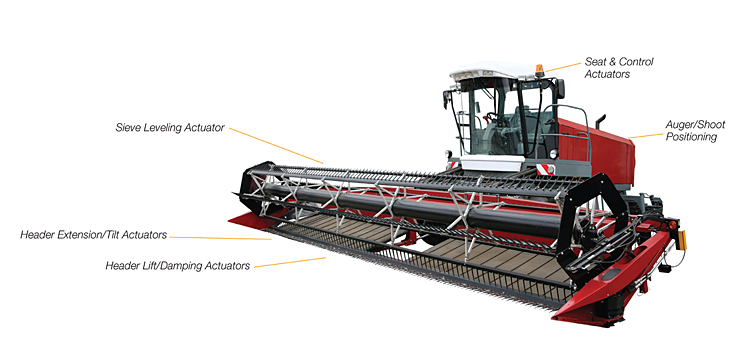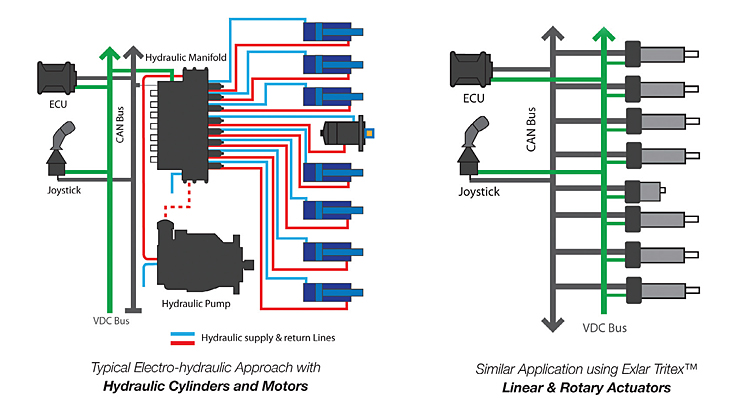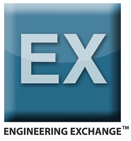For some mobile equipment applications, electric actuators bring a combination of high power density and high efficiency to places where hydraulics alone once ruled.
Designers of mobile equipment are facing pressure to use sustainable, energy efficient motion control technologies while still maintaining excellent power density and durability. To that end, there is a trend towards electric-powered alternatives. Using electro-mechanical actuators allows manufacturers to meet stringent emission regulations and accommodate smaller engine sizes while providing enhanced control and power integration. With the power density advantages of hydraulics, fluid power technologies will continue to be used in many applications. However, electric actuators are increasingly finding application in some mobile applications, making them a viable alternative to hydraulics.
By eliminating fluid conveyance layouts and the need for ancillary equipment—such as compressors, pumps and hoses—electric actuators have fewer mechanical demands, which simplifies machine design, operation and maintenance. Also, by integrating the controls and power circuitry within the actuator, electric actuators improve overall machine control in mobile applications for a broad scope of industries, ranging from agriculture and construction to aerospace and defense. This lets manufacturers use electric actuators in a variety of equipment to achieve high speeds and maximum force in compact, self-contained packages.
Advances in electric actuators
Electric actuators can often provide better energy efficiency than other technologies, due to their increased power density and higher conversion efficiency. In addition, electric actuators can enhance operator safety through quieter operation and reduced exposure to potentially high pressure or high temperature fluids.
Essentially, an electric actuator consists of an electric motor, a gearbox or gear reducer, and some type of lead screw. Some actuators are fitted with roller screws, which convert rotary motion into linear motion. Roller screws can offer longer travel life, higher rotational speeds, larger load capacities and greater efficiency than other screw types. Roller screws turn faster and cycle more frequently than acme and ball screws, making them a good fit for demanding, continuous-duty applications. With roller screws, all force transmission surfaces make contact uniformly, enabling efficient operation up to 6000 rpm with travel speeds up to 60 in./sec and load ratings of 40,000 lbs. and above.

This combine harvester can use electric actuators for a variety of tasks including auger shoot positioning, sieve leveling, and header extension and lift functions, among others.
Roller screws, or planetary roller screws, have some benefits over ball screws. For starters, they have more contact points. They’re also designed to have larger radii at the point of contact, meaning more contact points will fit within the same relative space. This lowers stresses and lengthens the functional life compared to a similarly sized ball screw system. For example, a one-in. diameter, 1.5-in. long roller screw provides an average of 200 contact points. The ball screw will have, at most, only 50 balls in pressure contact at any given time. This results in a much higher load carrying capacity for roller screws, up to 15 times greater, as well as improved stiffness.
Electric actuators also offer point-to-point connections between the electric actuators and control devices, eliminating the need for the additional equipment required in hydraulic systems—including valves, pumps, filters and hoses or tubing—minimizing the overall system complexity. This straightforward design, with the ability to accommodate integrated electronics, allows electric actuators to provide greater versatility adapting to current industry trends, such as the use of industrial networking technologies that can vary by industry.
With recent advancements in electric motor design, materials, and manufacturing processes along with the ability to use higher supply voltages on many mobile platforms, manufacturers can now achieve higher power densities with electromechanical actuators. Electric actuators are capable of withstanding harsh environments, and have even been successfully used in demanding aerospace and defense applications.
Integrating power and control
The balance between precision and power is becoming more prevalent and is motivating the use of “smart” components, on-board mobile computers and communication networks that connect and integrate various platform components. Furthermore, providing solutions that are easier to operate, maintain, and even assemble is critical as global competition drives costs down while demands for more “intelligent” platforms increases complexity.
Electric actuators are especially well-suited to take advantage of the increased prevalence of more intelligent systems. They can readily balance power with precision and speed through a variety of control strategies, making them a good choice in machine designs requiring both power and finesse. Electric actuators support both stand-alone controllers interfacing discretely or through network connectivity to fully integrated solutions where amplifiers and dedicated motion controllers are built into the actuator.
The actuator, drive and controller are integrated into one piece of equipment, eliminating the need for additional power supplies, separate power amplifiers and cables. With integrated control and communication interfaces, like the mobile industry standard CAN bus, such actuators can simplify design and integration. Also, distributing control to the actuator provides direct communication between the actuator and control system, making possible remote operation of the actuator. This allows operators to maintain precise control while simultaneously accommodating user safety, application mobility and design flexibility.
Total cost of operation
Electric actuators use less energy than fluid-powered alternatives, making them more efficient. By only consuming energy during operation, allowing motors to be powered down when not in use, electric actuators operate at approximately 90% efficiency. They can also provide production and maintenance benefits, reducing production times and mean time to repair.
With a simplified installation and connection process, electric actuators reduce assembly time, which can lower the overall cost of production. In-field replacements are also easier, limiting the amount of production downtime, in addition to eliminating the risk of any oil leaks/spills or product contamination during repairs. Plus, with the use of standardized electrical connectivity, they provide more atypical cost benefits, such as not requiring specialized skills in the assembly and maintenance areas.
Electric actuator applications
Traditionally, in mobile equipment applications, hydraulic systems were used for both propulsion and work functions. However, with increasing electrification primarily in propulsion and traction drives, electric actuators are being used for other functions within the vehicle such as steering, deck and chute positioning, and seat compensation.

A schematic comparison of a hydraulic system with one using electric actuators shows a reduction in components and the simplified connections that the electrical system offers.
For some mobile applications, operator comfort and reduced fatigue are important, both as a selling point and for regulatory compliance. By using electric actuators for operator seat compensation, manufacturers can control the vibration and shock felt by an operator in the vehicle. This type of compensation system requires actuators to manage high travel speeds, precision and potentially high intermittent forces, while operating quietly and reliably over a wide range of environmental conditions.
Electric actuation also has benefits for the turf care and construction equipment industries. For turf care, which includes professional greens mowers, replacing hydraulic actuators eliminates the concern with hydraulic leaks and potential damages to golf course greens, while providing more quiet operation and simplified maintenance. Typical uses for electric actuators can include steering, deck lift and positioning, reel mower positioning and seat compensation.
In construction equipment applications, such as aerial work platforms, an electric actuator’s precision, control integration and high speeds can allow for more adaptive controls such as in positioning and vibration compensation. This can also help address the use of less skilled operators where the control system and actuators adapt their performance based on the operator’s capability and factors such as wind, platform height, and angle.
Exlar Corp.
www.exlar.com
::Design World::
Filed Under: Factory automation, Actuators, Ballscrews • leadscrews, Hydraulic equipment + components, FLUID POWER, LINEAR MOTION, Motion control • motor controls






Tell Us What You Think!